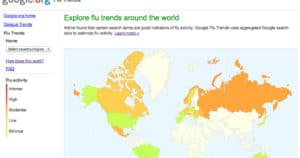Repost of an article from November, when the RSS on the site played a prank on me and stopped working.
Here’s a list of 13 not-so-interesting tidbits about Google, created in the hope that someone may not have heard of them yet. Here we go!
Spis treści
1. Google and old-school rich snippets
If you think rich snippets – or at least the principle behind them – is new, you are mistaken. The origins of the bankruptcy of online content creators can be traced to Google’s SMS Search service, which was active between 2004 and 2013.
What did this service consist of? On nothing complicated – just search via SMS. After sending an SMS query to the number 466453 (that is, G-O-O-G-L-E on the alphanumeric keypad), we received (or rather, Americans received) a response in the form of a return SMS.
It would be just such a curiosity if it were not for one remark – the return SMS did not contain links to the sites. It contained data, answers, information. Thus, it required the algorithm not only to understand the content of the SMS-sent query, but also to wyscrape a short but succinct response.
Doesn’t it remind you of something? E.g. contemporary rich snippets often robbing us of organic traffic? Their original form?
2. free phones, or how the algorithm learned speech
A service similar to SMS Search was the seemingly mysterious-sounding GOOG-411. It was an automated telephone service for finding local businesses, based on speech recognition.
Why the 411 in the name? In the US and Canada, 411 is generally a telephone information number. GOOG-411 was the equivalent of a phone book drawing data from the Internet. The difference was that it was an automated service; it recognized speech, suggested specific addresses and companies, and eventually routed the call to the selected company or sent an SMS with its number.
The service was quite popular between 2007 and 2010, and this was due to the fact that information at the 411 number was generally a rather salacious paid service, while the Google number was completely free.
What business did Google have in this?
This was explained (although I have a feeling she hasn’t fully thought it through) by Marissa Mayer, former vice president of Search Products & User Experience at Google:
You may have heard about our [directory assistance] 1-800-GOOG-411 service. Whether or not free-411 is a profitable business unto itself is yet to be seen. I myself am somewhat skeptical. The reason we really did it is because we need to build a great speech-to-text model …. that we can use for all kinds of different things, including video search.
The speech recognition experts that we have say: If you want us to build a really robust speech model, we need a lot of phonemes, which is a syllable as spoken by a particular voice with a particular intonation. So we need a lot of people talking, saying things so that we can ultimately train off of that. … So 1-800-GOOG-411 is about that: Getting a bunch of different speech samples so that when you call up or we’re trying to get the voice out of video, we can do it with high accuracy.
In short, Google wants to learn speech. So he needs people to speak to him. And where will they say more than to the handset of a free phone service that normally costs a lot?
3. the Knol, or Google’s version of Wikipedia
Google has tried to master probably all aspects of Internet activity, including those related to science, knowledge and, above all, information. In 2008, when Wikipedia had already turned 7 years old and was doing quite well, the beta of Knol, or Wikipedia made by Google, saw the light of day.
In fact, it might have worked, because the content creation model was a bit different from the online encyclopedia of Jimmy Wales and company. Knol offered the possibility of creating multiple articles written by different authors for a single issue. The articles emphasized a point of view, rather than a neutral, collective position as in Wikipedia.
In addition, Knol offered the option to include Adsense ads in the article, making the project a little less noble and more susceptible to spam and human greed.
The project also stirred up controversy because it was the first time it so explicitly put Google in the position of a content creator, rather than just an entity that catalogs and organizes content on the Internet.

The project was finally shut down in April 2012, and six months later all the collected content was removed. Two years earlier, Google gave the Wikimedia Foundation a $2 million grant.
4. when you get caught up in unnecessary philanthropy….
Between 2002 and 2006, Google made it available to government organizations, charities, nonprofits, universities, etc. to set up a special account. It allowed unfettered use of Google products without ads. This fit perfectly with the image of a young, modern company, which, after all, cares not about money, but about “cataloging the world’s information resources and making them universally accessible and useful.”
Well, something went wrong somewhere – I am not accusing Google of ill will. But the fact is that at some point in September 2006, it became apparent that there was a – quote – “security problem” in Public Service Search (for that was the name of the functionality).
What does a multimillion-dollar corporation do at such a time? It certainly doesn’t fix the problem. He makes a post on his blog announcing the “temporary fix” and then blocks access to the service.
And he tries at all costs never to mention her again.
5. the shortest offered Google service
From 2007 to 2014, there was a product called Google Questions and Answers. It was a service that we are still familiar with today from the principle of operation – such a model is used, for example. Quora or Stackoverflow, that is, someone asks a question and Internet users answer. There is always a specialist in a particular field in the crowd.
Its predecessor was Google Answers (2002-2006), a strange creation of its time, where the user paid to search for information. Approximately 500 so-called. researchers – Google-verified volunteers – searched for necessary information for amounts ranging from $2 to as much as $200. Amazingly, just 13 years ago, using a search engine was a skill you could make money from.
As if that wasn’t enough, the service also had a predecessor back in 2001. It was also a service called Google Questions and Answers. Here, too, questions could be asked, but for a fixed, unchangeable fee of $3. This was done not through the site, but by e-mail (!), and questions were answered not by specialists, but by ordinary Google employees. Someone did not foresee that a small number of employees might not be able to handle the barrage of emails from eager Internet users.
So Google’s Questions and Answers service only worked for about 24 hours.
6 Dr. Google against influenza
Fighting the flu with Google isn’t just about searching the Internet for its symptoms, which – at the end of the day anyway – will lead us to the conclusion that we are suffering from an advanced cancer of everything.
From 2008 to 2015, Google maintained the Google Flu Trends service. It was designed to predict (and thus partly counteract) influenza virus activity in more than 25 countries (including Poland).
The data was collected based on user activity and their online health-related behavior; primarily searches for flu-related phrases. The algorithm also took into account the searcher’s IP number, which made it possible to assess the regionality of current influenza outbreaks and their danger.
IP numbers were anonymized after 9 months; no humans but only machines were involved in the algorithmic calculations. Despite the public health benefit, there have been claims that Google Flu Trends violates the privacy of search engine users.

According to some studies, Google Flu Trends was able to predict the development of an influenza outbreak at approx. 10 days before it is reported to the relevant authorities. Excluding the 3 highly overestimated disease seasons, the predictability of illnesses remained at 97%.
In the United States alone, between 5 and 20 percent of the population falls ill with influenza each year; this leads to the deaths of an average of 36,000 people each year.
7. Google is not just about success
Many Internet users see Google as the golden child of the Internet boom, a tycoon destined for success. However, not by success alone is the history of this concern written. While the initial slip-ups are not surprising, the later wrong decisions and strategies, or products that are misfires with no staying power – are most surprising. Especially considering what percentage of the Internet market Google controls.
The biggest and perhaps most spectacular misfire is Google+, which I write about in a separate paragraph. Regardless of other reasons – Google+ has most simply failed to meet the demands of the market and has not even put up a meaningful fight against competitors like Facebook.
The most popular celebrity profiles on G+ (Lady Gaga, Snoop Dogg, or Madonna) were followed by about 8-9 million people, while on Facebook the numbers are several times higher.
Do you think Google learns from its mistakes and won’t try social media anymore? Already in production is Google Shoelace (for now only available in New York), an app for “connecting people with similar interests.” That is, as beautifully summed up by Matylda Grodecka on Spider’s Web:
Instead of taking to heart the maxim attributed to Einstein that it’s insane to do the same thing over and over again and expect different results, Google is following the words of another well-known 20th century figure – Oops, I did it again.
(…)
I must confess to you that there is a part of me that admires the iron determination and stubbornness with which Google bangs its head against the wall. For now, it’s admittedly about 10:0 for the wall, but the tech giant isn’t giving up.
Do you think Google+ is the only spectacular failure of this concern? The list is much longer:
- Google Schemer – a service for sharing and saving activities to do, similar in concept to Facebook events
- Google Health – a service for collecting data on health, medications, allergies, etc.
- Google Web Accelerator – internet “accelerator”, caused bugs in YouTube, tarnished user privacy
- Orkut – a social media site created long before G+; although it gained popularity in Brazil and India, it could not withstand competition from the giants
- Google Friend Connect, Jaiku, Google Buzz – more Google approaches to the topic of social media
- Google Offers – service initially similar to Groupon, then transformed into a coupon and discount service, closed in 2014
- Google Reader – Atom/RSS aggregator, closed due to waning interest
- Knol – Google’s version of Wikipedia, extinguished in 2012
- Nearby Notifications – a proximity marketing tool using, among other things. From beacons to bluetooth – abused and killed by spam
- Dragonfly – a search engine prototype for the Chinese market, which I write about in a separate paragraph
- Google Finance and Portfolios – Google’s recipe for failure: build a powerful product with financial investors in mind, get a powerful user base, don’t monetize the product, delete it without giving a reason
- Project Ara – a modular smartphone project scheduled for release in 2017
- Google Ride Finder – an application that indicates the nearest cab, limousine or bus
- Google Moderator, a crowdsourcing service for asking questions and sharing ideas, whose popularity has not lived up to Google’s expectations
- Google Hire, a service to help recruiters, launched just 3 years ago, is to be extinguished in September 2020
- Google Helpouts – a service where you could get paid help from a live specialist in a particular field
- Google Spaces, a service that was supposed to be a competitor to Slack, extinguished in spring 2017
- Google Bulletin, a service that relays news in local communities, has not come out of a pilot program
- and many, many others.
The 8th nail in the coffin of Google+
Although Google with a plus was an all-around failed product, in my opinion, low popularity was not the only reason for its extinction. Although Google had managed to collect as many as 540 million users by early 2014, nearly half remained completely inactive. 90% of site visits lasted less than 5 seconds. Even forcing a Youtube contributor to have Google+ to comment on his own video didn’t help. In a 2012 benchmark study from ComScore, users spent an average of 3.3 minutes per month on G+, compared to 7.5 hours on Facebook.

October 2018 brought news of the extinction of the Google+ version for individual users, which finally took place in the spring of 2019. And while we’ve all taken this as an admission of defeat and a retreat from the race for social media dominance, it’s not always said what was really the nail in G+’s coffin.
And there was. a possible data leak. A leak that no one has proven, that may not even have occurred. But the possibility of a leak certainly occurred, which for Mountain View decision-makers was the drop that overflowed the blackness of bitterness.
In the spring of 2018, for 6 days, the Google+ API shared the private data of more than 50 million users with developers. There is no evidence that anyone “took advantage” of the bug, but the event has ultimately doomed the future of Google+.
9. dragonfly, or a long history of cooperation with the censor
The ideas behind Internet developers, such as unrestricted access to information or the ability to express one’s views, sound beautiful in the mouths of spokespeople, but are mixed with mud when it comes to cash.
And the cash is plentiful in the Chinese market, which Google has a hankering for. The California-based giant was already there from 2006 to 2010, serving the Chinese with information through the Google.cn domain. Of course, this information was shamelessly censored. When you typed in a phrase related to a topic on Beijing’s banned list, Google displayed a relevant censorship notice.

Because after 4 years of presence in the Chinese market, Google had captured only 35% of the (then relatively small) market there, Sergey Brin suddenly remembered human rights, freedom of speech and other issues that had been swept under the rug for 4 years. Google left China half-heartedly, redirecting traffic to a version of Google.hk (Hong Kong), until that version was eventually completely blocked by Beijing. With its last strength, the corporate hydra clung to its earnings.
For nearly a decade of Google’s absence in China, the market there has grown by more than 70%, and analysts predict a possible doubling. So Google is sharpening its claws on this market, and it’s doing it in a way that’s…. well, not very elegant.
Dragonfly is a project that the public would only learn about after it was implemented, despite the fact that more than 100 Google engineers worked on it. There are rumors that the privacy and security departments have been excluded from work on this product. For good reason. We only learned the details of the project through a leak published on The Intercept.
Dragonfly was (is?) a prototype of an Internet search engine designed by Google for the Chinese market. The controversy over the way it works is based on two basic objections.
First, the search engine links the phrases entered with the phone number of the user who entered the phrase. Orwell wouldn’t have come up with that.
Second, the search engine would not only censor content deemed “inappropriate” by Beijing, but on top of that, it would not inform the user that he or she had just been slapped across the face with a harsh censor’s whip.
In the previous version of Google.cn, the user at least knew that a topic was inconvenient and censored for the government – so he could look for information in other sources. Dragonfly was supposed to create for Chinese users the illusion of a country flowing with milk and honey, like TVP Info at its peak.
The result? Scandal. More than 1,400 Google employees have signed a letter demanding greater transparency in the work on Dragonfly. A $200,000 strike fund for Google employees has been raised – the protest would begin if Dragonfly is implemented. Amnesty International’s firm opposition. Strong opposition from many key politicians.
In July 2019, testifying before the Senate Select Committee on Intelligence. Justice Karan Bhatia announced that work on Dragonfly has been discontinued. What would have happened if not for the leak and disruption of the prototype work? Arguably, Google would have just carved itself a solid piece of the market pie in China, at the expense of freedom of speech.
Google repeatedly assured that Dragonfly was far from being implemented, and that it was just an interesting case: we felt it was important for us to explore. At the same time, the note made public by journalists shows a wish: the future is uncertain, but the application is expected to be ready in 6-9 months.
10. who sniffed out success: early investors

Jeff Bezos, one of Google’s early investors
photo. Seattle City Council
We all know Larry Page and Sergey Brin. Some may still be familiar with Scott Hassan, who actually wrote the first version of Google himself. But the search engine’s electrifying success would not have been possible if not for early investors who sensed enormous potential in the university project. Who were they?
- Andy Bechtolsheim – Google’s first major investor – backed the young enthusiasts with $100,000 before they even registered the business. Bechtolsheim is a co-founder of Sun Microsystems, the company responsible for, among other things. For creating the Java language.
- Jeff Bezos – needs no introduction, the creator of Amazon. Its shares bought back for $250,000 in 2017 were worth more than $3 billion
- David Cheriton – Canadian scientist and investor; his $200,000 check to Google brought him a return of approx. 1 billion dollars.
- Ram Shriram – an American businessman previously working with Amazon and Netscap.
- Kleiner Perkins, an investment fund with a portfolio of holdings including. On Amazon, Electronic Arts or Twitter.
- Sequoia Capital, an investment fund that invests in, among other things. In Apple, PayPal, Yahoo, WhatsApp or Instagram.
11. secure Google address
Although it’s hard to imagine today, less than 10 years ago, in order to search for information on the Internet in a secure SSL protocol, we had to go to a special address: encrypted.google.com.
The site appeared in May 2010, with industry sites describing it as “a new technology that Google is testing,” although SSL as a standard appeared back in the 1990s.
After that, things went a little faster, and SEOs and analysts had to swallow the bitter pill called not provided. First, in October 2011, Google redirected all logged-in users to the https version, and in 2016 it redirected those not logged in as well.
And now the bombshell: Google has encouraged webmasters to secure sites with certificates and use the https protocol. What is its persuasive power? According to the Transparency Report, such:

Beginning November 2019, US. The percentage of pages opened in Chrome using https is 92%. That’s impressive, considering that just 3 years ago Google itself did not force the use of a protected version when searching.
12. it’s not a competition, it’s a sandbox
Between 2006 and 2008, Google was already second to none and the market leader in search engines. It was at this time that Mountain View engineers decided to take an odd step – they created a competing search engine, SearchMash. It didn’t win a large share of the market, of course, but a number of users drifted away from Google to the new product, which, surprisingly, was not branded, i.e. nowhere in a prominent place did it say that the search engine’s creators were Google employees.
SearchMash was something that today is being replaced by continuous testing on live users – it was a sandbox search engine for conducting research, testing functionality and new ideas. And perhaps it was these new ideas and innovations that caused a certain set of users to use this sandbox more readily than Google itself.
It was SearchMash that was the testing ground for many features that seem obvious today. It was there that results from different channels – web, images, video, Wikipedia – were first mixed on one SERP page. There they tested infinite scroll, results in Flash, tried different versions of the interface.
The first significant experiment already conducted on a living organism, after SearchMash was shut down, was SearchWiki. This was the ability to vote (and thus elevate down or up) on individual search results and add notes to them. Two years later, no one had heard of SearchMash or SearchWiki anymore.
13. other interesting facts and links
Google’s first official headquarters was a garage owned by Susan Wojcicki, who held both Polish and American citizenship. Susan became Google’s first marketing manager. He is currently CEO of YouTube. In 2017, she ranked 6th. ranked in Forbes’ World’s 100 Most Powerful Women. Her sister Anne, founder of 23andMe (a company that creates consumer genetic tests) was married to Sergey Brin for 8 years.
And the first time the verb “to google something” was used in the TV series “Buffy. Fear of Vampires.”
In contrast, Alphabet’s 2018 revenue was nearly $137 billion, an amount similar to Kuwait’s or Ukraine’s GDP, is 2 times higher than Bulgaria’s GDP and 10 times higher than Armenia’s GDP.
And that would be it for today.


